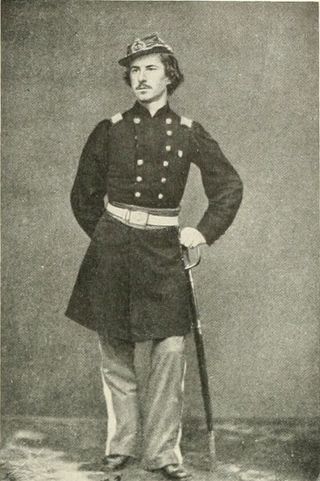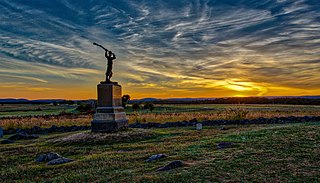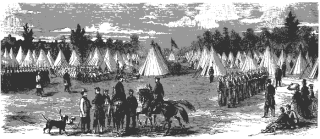
Elmer Ephraim Ellsworth was a United States Army officer and law clerk who was the first conspicuous casualty and the first Union officer to die in the American Civil War. He was killed while removing a Confederate flag from the roof of the Marshall House inn in Alexandria, Virginia.

The 69th Pennsylvania Infantry was an infantry regiment in the Union army during the American Civil War.

The 72nd Pennsylvania Infantry was a volunteer infantry regiment which served in the Union Army during the American Civil War. It was part of the famous Philadelphia Brigade.
The 6th New Jersey Infantry Regiment was regiment of infantry from New Jersey that served in the Army of the Potomac during the American Civil War.

The 62nd New York Infantry Regiment was an infantry regiment that served in the Union Army during the American Civil War. It is also known as the Anderson Zouaves.

The 4th Michigan Infantry Regiment was an infantry regiment that served in the Union Army during the American Civil War. The 4th Michigan wore a very Americanized zouave uniform. This uniform consisted of a Federal dark blue 4 button sack coat, dark blue chasseur trousers, tan gaiters, and a maroon zouave fez with a light blue tassel.
The 19th Regiment Illinois Volunteer Infantry was an infantry regiment that served in the Union Army during the American Civil War. Three companies formerly with Col. Elmer Ellsworth's Zouave Cadets wore a zouave uniform consisting of a dark blue zouave jacket with red trimmings, red pants, leather gaiters, a sky blue shirt, red sash, and a red French styled kepi with a dark blue band. The jacket cuffs were trimmed in yellow-orange and red. Brass buttons went down both fronts of the jacket. They were organized into four separate companies on May 4, 1861, in Chicago. It was consolidated and mustered into Federal service as the 19th Illinois Volunteer Infantry on June 17, 1861. It was mustered out at Chicago on July 9, 1864.

The 14th Regiment New York State Militia was a volunteer militia regiment from the City of Brooklyn, New York. It is primarily known for its service in the American Civil War from April 1861 to 6 May 1864, although it later served in the Spanish–American War and World War I.

The 5th New York Veteran Infantry Regiment was an Infantry Regiment that served in the Union Army during the American Civil War. The regiment was known as "Duryée‘s Zouaves." The regiment had two uniforms during its time. The first uniform consisted of a medium blue zouave jacket with red trimming, a grey shirt, a red sash with sky blue trimming, red chasseur trousers with yellow piping, a red fez with a yellow tassel, and a white turban. The second and official uniform consisted of a dark blue zouave jacket with red trimmings in the Hawkin Zouave design, a dark blue zouave vest with red trimming, baggy red trousers, a red sash with sky blue trimming,a red fez with a yellow tassel, and a white turban.

The 11th New York Infantry Regiment was an infantry regiment of the Union Army in the early years of the American Civil War. The regiment was organized in New York City in May 1861 as a Zouave regiment, known for its unusual dress and drill style, by Colonel Elmer E. Ellsworth, a personal friend of U.S. President Abraham Lincoln. Drawn from the ranks of the city's many volunteer fire companies, the unit was known alternately as the Ellsworth Zouaves, First Fire Zouaves, First Regiment New York Zouaves, and U.S. National Guards.

The 73rd New York Infantry Regiment was an infantry regiment of Union Army in the American Civil War. The regiment was organized in New York City in May 1861, originally under the designation the Fourth Excelsior Regiment, as a Zouave regiment, known for its unusual dress and drill style. The uniform worn by this regiment consisted of a dark blue chasseur jacket with light blue trim and light blue trefoils on each sleeve, sky blue chasseur trousers with two white stripes down each leg, brown leather gaiters, a light blue kepi with a dark blue band and dark blue piping, and a red Zouave fez with a blue tassel as a fatigue cap. Drawn from the ranks of the city's many volunteer fire companies, the unit was known alternately as the Second Fire Zouaves, after the 11th New York was known as the First Fire Zouaves, and they were also known as the Excelsior Zouaves. Some of the men wore the brass letters "E Z" on the bands of their kepis. Many artists have depicted this regiment also with red shirts with the collar sticking out over the jacket creating a "red collar."

James Clay Rice was a lawyer from Massachusetts who became a brigadier general of volunteers in the Union Army during the American Civil War. He was killed at the Battle of Spotsylvania Court House in May 1864.

The 140th New York Infantry Regiment was a volunteer infantry regiment that was created on September 13, 1862, for the Union Army during the American Civil War. From January 1864 they wore a Zouave uniform.

The 146th New York Infantry Regiment, nicknamed Garrard's Tigers, was a Federal regiment which mustered on October 10, 1862, and mustered out on July 16, 1865. The regiment was raised and organized in Rome, New York, and was known as the 5th Oneida Regiment. Another nickname for this unit was the Halleck's Infantry, after New York-born general Henry Halleck.

The 114th Regiment, Pennsylvania Volunteer Infantry was an infantry regiment that served in the Union Army during the American Civil War. They were notable for their colorful Americanized version of the Zouave uniform worn in emulation of certain French light-infantry units that became world-famous during France's colonization of North Africa, the Crimean War, and the Second War of Italian Independence fought in the years prior to the American Civil War.

Arthur Forrester Devereux was a captain in the Massachusetts Volunteer Militia prior to the Civil War and a colonel in the Union Army during the Civil War. He is notable for his expertise and proficiency in the instruction of military drill. During the Battle of Gettysburg, the 19th Massachusetts Infantry, under his command, played an important role in filling a breach in the Union lines during Pickett's Charge. After his active service had concluded, Devereux was awarded the honorary rank of brevet brigadier general, United States Volunteers, by appointment of President Andrew Johnson on February 21, 1866, to rank from March 13, 1865, and confirmation by the U.S. Senate on April 10, 1866.

The 74th New York Infantry Regiment was a Union regiment recruited in 1861, during the American Civil War. The regiment was part of Sickles' Excelsior Brigade and their first commander was sailor and engineer COL Charles K. Graham.

The United States Zouave Cadets was a short-lived zouave unit of the Illinois militia that has been credited as the force behind the surge in popularity of zouave infantry in the United States and Confederate States in the mid-19th century. The United States Zouave Cadets were formed by Elmer Ellsworth in 1859 from the National Guard Cadets of Chicago, established three years earlier. The unit's 1860 tour of the eastern United States popularized the distinctive zouave appearance and customs, directly and indirectly inspiring the formation of dozens of similar units on the eve of the American Civil War.

Eugene Beauharnais Payne was a brevet brigadier general of the Union Army in the American Civil War and an Illinois State Representative.

The 53rd New York Volunteer Infantry Regiment, also known as D'Epineuil's Zouaves or the Poughkeepsie Boys was an infantry unit of the Union Army organised in New York City for service in the American Civil War.













